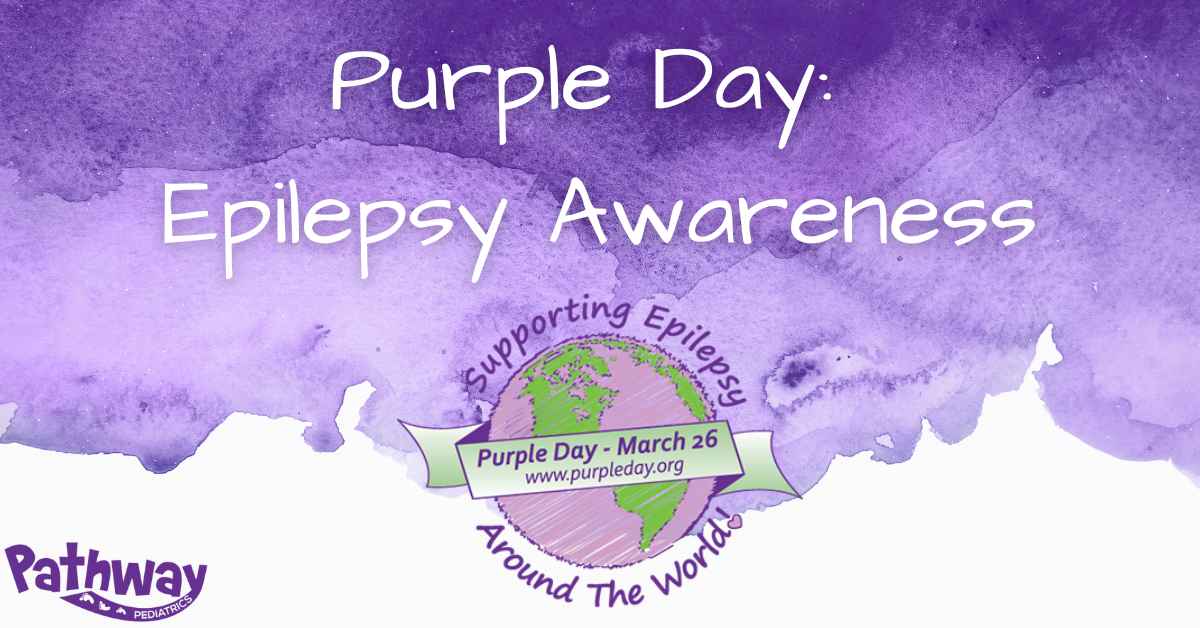Purple Day: Epilepsy Awareness
March 22, 2023

March 26th is Purple Day for Epilepsy Awareness. People around the US and the world will wear purple to raise awareness for epilepsy and some will even host events to raise funds and support for those with epilepsy. So what exactly is epilepsy?
Defining Epilepsy:
Epilepsy, sometimes called a seizure disorder, is a disorder of the brain that causes seizures. A seizure is a short change in normal brain activity. A person is diagnosed with epilepsy when they have had two or more seizures. These seizures are not caused by a temporary underlying medical condition such as a high fever. Epilepsy is not contagious.
The way a seizure looks depends on the type of seizure a person is experiencing. Some seizures can look like staring spells. Other seizures can cause a person to collapse, shake, and become unaware of what’s going on around them. A person with epilepsy can have more than one kind of seizure.
Epilepsy can affect people in very different ways. This is because there are many causes and many different kinds of seizures. Some people may have multiple types of seizures or other medical conditions in addition to epilepsy. These factors play a major role in determining both the severity of the person’s condition and the impact it has on his or her life.
What Causes Epilepsy?
Epilepsy can be caused by different conditions that affect a person’s brain. Many times the cause is unknown. Some causes include:
- An imbalance of nerve-signaling brain chemicals (neurotransmitters)
- Stroke
- Brain tumor
- Traumatic brain injury or head injury
- Central nervous system infection
- Brain infection from parasites and/or bacteria
- Loss of oxygen to the brain
- Some genetic disorders (such as Down syndrome)
- Other neurologic diseases (such as Alzheimer’s)
For 2 in 3 people, the cause of epilepsy is unknown. This type is called cryptogenic or idiopathic.
If you have one seizure, that does not always mean you have epilepsy. Seizures can also happen because of other medical problems including a high fever, low blood sugar, and alcohol or drug withdrawal.
How Common is Epilepsy?
65 Million people worldwide have epilepsy- 1 in 100 people.
In 2015, 1.2% of the US population had active epilepsy. This is about 3.4 million people with epilepsy nationwide: 3 million adults and 470,000 children.
In the state of Alabama, as of 2015, had 54,100 cases with 7,500 of those being children 0-17 years old.
Epilepsy in Children
Epilepsy looks very similar in both children and adults. Some symptoms of a seizure include:
- Staring
- Jerking movements of the arms and legs
- Stiffening of the body
- Loss of consciousness
- Breathing problems or stopping breathing
- Loss of bowel or bladder control
- Falling suddenly for no apparent reason, especially when associated with loss of consciousness
- Not responding to noise or words for brief periods
- Appearing confused or in a haze
- Nodding head rhythmically, when associated with loss of awareness or consciousness
- Periods of rapid eye blinking and staring.
During the seizure, your child’s lips may become tinted blue and his or her breathing may not be normal. After the seizure, your child may be sleepy or confused.
The symptoms of a seizure may be similar to those of other health conditions. Make sure your child sees his or her healthcare provider for a diagnosis.
How are Seizures Treated in Children?
The goal of treatment is to control, stop, or reduce how often seizures occur. Treatment is most often done with medicine. Other treatments include a ketogenic diet, vagus nerve stimulation, and in extreme cases, surgery. Treatments are selected based on the type and frequency of seizures, age of the child, side effects, cost, and ease of use.
It is important to follow your child’s treatment plan on time and as prescribed. Talk with your child’s healthcare provider about exact doses, possible side effects, and other specific details of your child’s specific treatment plan. Do not stop giving medicine to your child. This can cause more or worse seizures.
Your child may not need treatment for life. Some children are taken off medicine if they have had no seizures for 1 to 2 years. This will be determined by your child’s healthcare provider.
How Can I Help My Child Live With Epilepsy?
You can help your child understand and manage his or her own health. Make sure to:
- If age-appropriate, make sure your child understands the type of seizure he or she has, what to do if one occurs, and the type of medicine that is needed for it.
- Know the dose, time, and side effects of all medications. Give you child medicine exactly as directed. If old enough, teach them about their medications as well.
- Talk with your child’s healthcare provider before giving them any other medicine as some seizure medications can interact with many other medications. This can cause the medicines to not work well or cause side effects.
- Help you child avoid anything that may trigger a seizure. Make sure they get enough sleep, as lack of sleep can trigger a seizure.
- Make sure your child visits their healthcare provider regularly. Have you child tested as often as necessary.
Sources: CDC, Johns Hopkins, Purple Day
Next Post >>